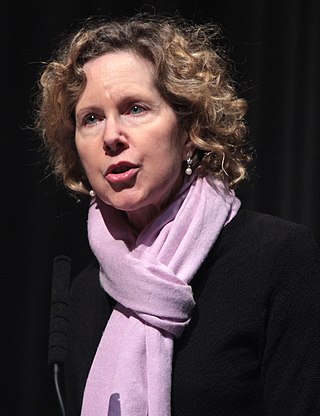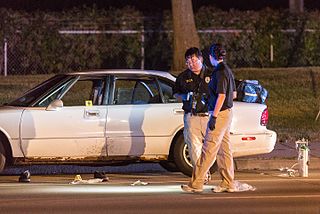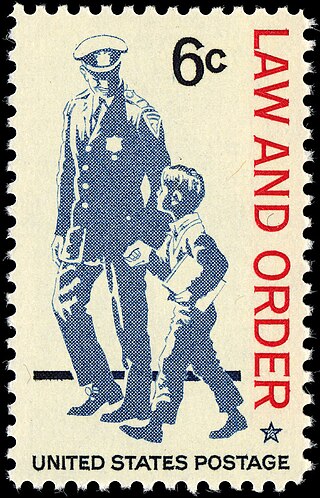Related Research Articles
Suicide by cop, also known as suicide by police or law-enforcement-assisted suicide, is a suicide method in which a suicidal individual deliberately behaves in a threatening manner, with intent to provoke a lethal response from a public safety or law enforcement officer to end their own life.
A lone wolf attack, or lone actor attack, is a particular kind of mass murder, committed in a public setting by an individual who plans and commits the act on their own. In the United States, such attacks are usually committed with firearms. In other countries, knives are sometimes used to commit mass stabbings. Although definitions vary, most databases require a minimum of four victims for the event to be considered a mass murder.
In the United States, the relationship between race and crime has been a topic of public controversy and scholarly debate for more than a century. Crime rates vary significantly between racial groups; however, academic research indicates that the over-representation of some racial minorities in the criminal justice system can in part be explained by socioeconomic factors, such as poverty, exposure to poor neighborhoods, poor access to public and early education, and exposure to harmful chemicals and pollution. Racial housing segregation has also been linked to racial disparities in crime rates, as blacks have historically and to the present been prevented from moving into prosperous low-crime areas through actions of the government and private actors. Various explanations within criminology have been proposed for racial disparities in crime rates, including conflict theory, strain theory, general strain theory, social disorganization theory, macrostructural opportunity theory, social control theory, and subcultural theory.

As of 2020, more than 800,000 sworn law enforcement officers have been serving in the United States. About 137,000 of those officers work for federal law enforcement agencies.

Active shooter is a term used to describe the perpetrator of an ongoing mass shooting. The term is primarily used to characterize shooters who are targeting victims indiscriminately and at a large scale, who oftentimes, will either commit suicide or intend to be killed by police. More generally, an active perpetrator of a mass murder may be referred to as an active killer.

Heather Lynn Mac Donald is an American conservative political commentator, essayist, attorney, and author. She is known for her pro-police views and opposition to criminal justice reform. She is a fellow of the Manhattan Institute think tank and a contributing editor of its City Journal.
Crime in Chicago has been tracked by the Chicago Police Department's Bureau of Records since the beginning of the 20th century. The city's overall crime rate, especially the violent crime rate, is higher than the US average. Gangs in Chicago have a role in the city's crime rate. The number of homicides in Chicago hit a 25-year high in 2021.

A line of duty death (LODD) is a death in the fire service or the police service while on duty.

Crime in Minnesota encompasses a wide range of unlawful activities that occur within the state, regulated by both state and federal laws. While crime rates in Minnesota are generally below the national average, certain areas and types of crime have garnered public attention.

Proactive policing is the practice of deterring criminal activity by showing police presence. It includes activities such as the use of police powers by both uniformed and plainclothes officers, engaging the public to learn their concerns, and investigating and discovering offences and conspiracies to commit crimes so that the crimes cannot be committed. In contrast, responding to a complaint after a crime has been committed is reactive policing.

Below are lists of people killed by law enforcement in the United States, both on duty and off duty. Although Congress instructed the Attorney General in 1994 to compile and publish annual statistics on police use of excessive force, this was never carried out, and the Federal Bureau of Investigation does not collect these data.
The stop-question-and-frisk program, or stop-and-frisk, in New York City, is a New York City Police Department (NYPD) practice of temporarily detaining, questioning, and at times searching civilians and suspects on the street for weapons and other contraband. This is what is known in other places in the United States as the Terry stop. The rules for the policy are contained in the state's criminal procedure law section 140.50 and based on the decision of the US Supreme Court in the case of Terry v. Ohio.

Police reform in the United States is an ongoing political movement that seeks to reform systems of law enforcement throughout the United States. Many goals of the police reform movement center on police accountability. Specific goals may include: lowering the criminal intent standard, limiting or abolishing qualified immunity for law enforcement officers, sensitivity training, conflict prevention and mediation training, updating legal frameworks, and granting administrative subpoena power to the U.S. Department of Justice for "pattern or practice" investigations into police misconduct and police brutality.
The Ferguson effect is an increase in violent crime rates in a community caused by reduced proactive policing due to the community's distrust and hostility towards police. The Ferguson effect was first proposed after police saw an increase in violence following the 2014 shooting of Michael Brown in Ferguson, Missouri. The term was coined by Doyle Sam Dotson III, the chief of the St. Louis police, to account for an increased murder rate in some U.S. cities following the Ferguson unrest. Whether the Ferguson effect really exists is subject of discussions with many published studies reporting contradicting findings concerning whether there is a change in crime rates, number of 911 calls, homicides, and proactive policing. Furthermore, the effect and influence of the portrayal of police brutality in the media is also contested.
In the United States, use of deadly force by police has been a high-profile and contentious issue. In 2022, 1,096 people were killed by police shootings according to The Washington Post, while according to the "Mapping Police Violence" (MPV) project, 1,176 people were killed by police in total. MPV documented 1,213 killings by police for 2023.
Denise Claire Gottfredson is an American criminologist and professor in the department of criminal justice and criminology at the University of Maryland, College Park.

Anti-police sentiment refers to a social group or individual's attitude and stance against the policing system.
In late May and early June 2020, two ambush-style attacks occurred against security personnel and law enforcement officers in California. The attacks left two dead and injured three others.
References
- ↑ Rushin, Stephen; Edwards, Griffin (March 2017). "De-Policing". Cornell Law Review. 102.
- ↑ Kaste, Martin (8 January 2015). "When Morale Dips, Some Cops Walk The Beat — But Do The Minimum". NPR. Retrieved 30 April 2016.
- ↑ MacDonald, Heather (2016). The War on Cops. New York, NY: Encounter Books. pp. 31–35. ISBN 9781594038761.
- ↑ Kelling, George (March 1982). "Broken Windows". The Atlantic. The Atlantic Monthly Group. Retrieved 2016-10-23.
- ↑ Rosenfeld, Richard; Wallman, Joel (2019). "Did de-policing cause the increase in homicide rates?". Criminology & Public Policy. 18 (1): 51–75. doi:10.1111/1745-9133.12414. ISSN 1745-9133. S2CID 159354985.
- 1 2 3 "Analyzing the State of U.S. Policing". FBI: Law Enforcement Bulletin. Retrieved 2020-07-31.
- ↑ "The Assailant Study - Mindsets and Behaviors" (PDF). Federal Bureau of Investigation, Office of Partner Engagement. Retrieved 2020-07-30.
- ↑ Court of Appeals, US (2014-02-21). "Ligon vs. New York City". FindLaw. Thomson Reuters. Retrieved 2016-10-23.
- ↑ Court of Appeals, US (2014-10-31). "Floyd vs. New York City". Findlaw. Thomson Reuters. Retrieved 2016-10-23.
- ↑ Fagan, Jeffery; Richman, Daniel (2017). "Understanding Recent Spikes and Longer Trends in American Murders". Columbia Law School, Faculty Scholarship.